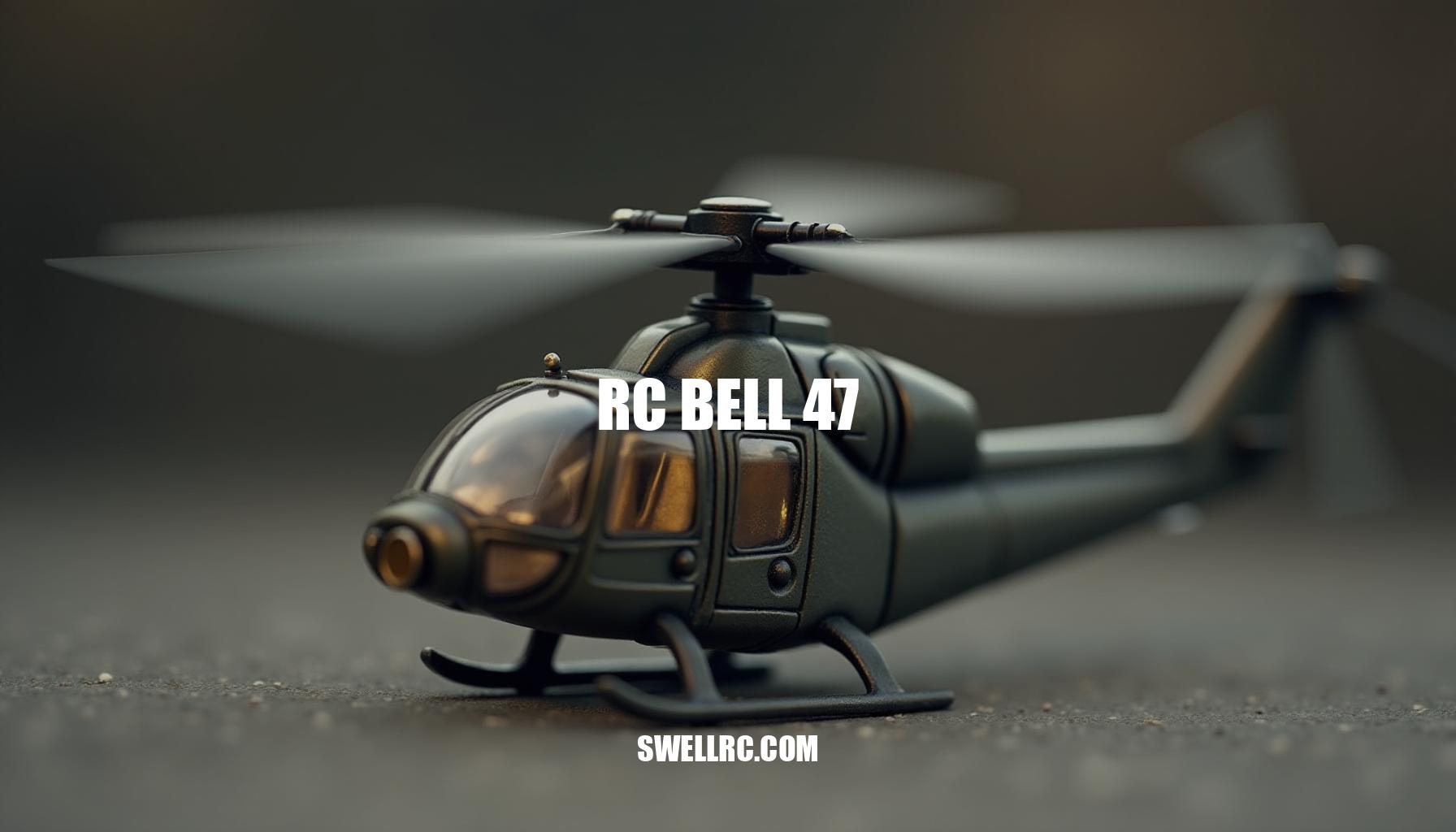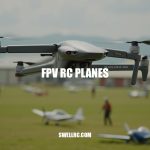The Ultimate Guide to RC Bell 47 Helicopters
I’ll never forget the first time I laid eyes on a full-scale Bell 47’s iconic bubble canopy and delicate lattice tail boom up close—its unmistakable silhouette instantly pulled me deep into the captivating world of RC helicopters. Knowing that this classic Bell helicopter history stretches back decades, I felt a connection when I picked up the Bell 47 RC model, a beautiful scale model helicopter that artfully blends nostalgia with authentic flight realism. Unlike its more aerobatic or multi-rotor cousins—such as the heavy-lifting Boeing CH-47 Chinook RC helicopter—the Bell 47 emphasizes visible mechanics, exceptional hover stability, and slow, cinematic flight, making it an enduring favorite among scale modelers and vintage RC aircraft enthusiasts alike.
In this article, I’m excited to share insights from months of weekend test flights to explore the Bell 47’s thoughtful design, building experience, true-to-life flight feel, routine maintenance, and how it stacks up against other beloved scale helis.
Whether you’re passionate about radio control flying or a fan of RC aviation history, this deep dive into the Bell 47 RC model offers a warm, credible perspective on why this helicopter continues to charm and inspire pilots around the world.
Section One – Where It All Began: The Real Bell 47 and Its RC Evolution
The Bell 47 helicopter is a true milestone in aviation history, recognized as one of the first helicopters certified for civilian use. Its distinctive bubble canopy offered pilots an almost panoramic view, while the steel-tube truss fuselage provided a strong yet lightweight frame. At the top, a two-blade teetering rotor system—the simplest kind where the blades pivot to stay balanced—gave the Bell 47 smooth lift and control.
These design elements inspired the Bell 47 helicopter model used in RC (radio-controlled) flying.
In the world of RC modeling culture, these real-world design cues translate beautifully into scale RC builds. Open-frame designs highlight the helicopter rotor system mechanics, while transparent canopies showcase detailed cockpits that mimic the original’s look and feel. A focus on smooth collective pitch—which means the pilot can change the angle of the rotor blades all at once to rise, hover, or descend more precisely—makes the RC Bell 47 especially good at stable hovering and gentle forward flight.
Think of collective pitch as the helicopter’s ability to adjust how much air the blades push down, controlling altitude and speed smoothly.
The Bell 47’s legacy continues in modern RC models like the Airwolf Black Bell 222 Electric Scale 1/3.5, which brings more power and sleek styling to the table, or the twin-rotor RC CH-47 Chinook that offers a whole new level of lifting ability and complexity. Each model appeals to different tastes in the Bell helicopter history and scale RC builds world.
| Model | Rotor Diameter | All-Up Weight | Power System (Motor/ESC/Battery) |
Flight Style | Build Complexity | Parts Availability |
|---|---|---|---|---|---|---|
| RC Bell 47 | 800 mm | 1.2 kg | Brushless / 30A ESC / 3S LiPo | Scale cruising, stable hover | Moderate (open frame, visible mechanics) | Good (many aftermarket options) |
| Airwolf Black Bell 222 | 870 mm | 1.8 kg | Brushless / 40A ESC / 4S LiPo | Scale cruising, some aerobatics | Higher (complex shell, detailing) | Moderate (fewer parts but improving) |
| RC CH-47 Chinook | 1200 mm (twin rotors) | 3.5 kg | Brushless / 60A ESCs (x2) / 6S LiPo | Scale cruising, heavy lifting | High (twin-rotor mechanics) | Moderate (specialized parts) |
Whether you’re drawn to classic utility helicopters like the Bell 47, the high-tech flair of the Bell 222, or the power-packed twin-rotor dynamics of the Chinook, RC helicopter kits offer something special. They celebrate Bell helicopter history while inviting enthusiasts to dive into the fascinating world of helicopter rotor systems and collective pitch control to master smooth, scale-like flying experiences.
Section Two – Building and Flying the RC Bell 47: A Test Pilot’s Journal
Embarking on my latest scale RC build was an exhilarating journey—one that taught me the importance of precision and patience. I began by choosing the perfect kit size, settling on a 600-class helicopter; this balanced well between manageable size and impressive presence. For the frame materials, I opted for an aluminum chassis to ensure durability without excessive weight, giving me a solid foundation for all subsequent steps.
Fitting the clear canopy was a meticulous process to achieve a seamless, scale-accurate look. I carefully installed scale details like skids, antennas, and a dummy engine that truly brought the model to life. Throughout the build, I leaned heavily on tools that made complex steps easier.
Essentials included:
- Ball-link pliers for tight, precise control linkage adjustments
- Digital pitch gauge to set accurate collective pitch angles
- Swash leveler to ensure perfect rotor tuning and flight controller responsiveness
- Threadlocker to secure screws against vibration-induced loosening
One often overlooked task I tackled diligently was main shaft shimming, which proved critical for smooth rotational dynamics. I also took extra time aligning the tail belt and gears, a step easy to miss but indispensable for stable tail rotor operation.
When configuring electronics, I selected a motor with a KV rating tailored to produce gentle head speeds reminiscent of the real Bell 47’s iconic rotor sound. Implementing an ESC governor helped maintain consistent RPMs during flight, improving hover stability. Battery choice varied between 3S and 12S LiPos depending on the size and power needs of the build.
The FBL flight controller setup was fine-tuned for optimal gain settings and responsive cyclic/collective inputs, complete with a rescue mode for safety. Notably, dialing in gentle head speeds made the Bell 47 model feel stunningly authentic—after multiple weekend test flights, I found the sweet spot head speed where the canopy stops shimmering and the skids look rock steady in a hover.
The first flights were revelations: spool-up was remarkably smooth, and the rotor responded instantly to inputs. Hovering in light wind conditions demonstrated excellent stability while flying gentle circuits allowed me to savor that exposed frame feel—every control input felt immersive and intimate.
Post-flight troubleshooting became part of the learning curve, with issues and solutions including:
- Tail wag at mid-throttle: lowering gyro gain or verifying tail blade balance helped eliminate oscillations.
- Nose bobbing in hover: reducing main head gain and checking CG and dampers significantly improved stability.
- Vibration buzz near 60–70% throttle: re-tracking blades, inspecting feathering shaft, and double-checking motor pinion mesh resolved annoying vibrations.
- Overheating ESC on long scale hovers: increasing airflow, lowering head speed, or upgrading to higher-capacity batteries effectively reduced temps.
Throughout the project, I found inspiration in the robust mechanics pioneered by Bergen RC helicopters and skill-building insights from the Vario Robinson R22 RC helicopter. Their meticulous approach to parts quality and setup discipline informed every stage, underscoring the value of thoughtful flight controller setup and rotor tuning for creating a superbly stable and authentic flying experience.
Section Three – Why the RC Bell 47 Still Captivates Collectors
The Bell 47 RC model captivates enthusiast hearts with its unique open lattice design, laying bare the elegant complexity of its linkages, servos, and rotor head. This exposure turns the model into a living mechanical sculpture, offering a visual feast that few collector RC helicopters can match. Perfect for display model helicopter fans, it fits beautifully on hangar shelves or office mounts, where ambient lighting through its clear canopy accentuates every intricate detail.
Its slow, graceful flights evoke potent nostalgia, delivering the type of cinematic charm that quicker aerobatic models simply cannot replicate.
Practical customization unlocks even more personality: consider gentle weathering on the skids and frame joints to add authentic wear; applying period-correct color schemes to deepen vintage vibes; introducing pilot figures or medical/rescue accessories to enhance storytelling; and carefully routing wires to maintain the visual cleanliness of the open frame. Such scale detailing elevates the model’s presence among other revered classics cherished by the RC community. For example, the celebrated Hirobo helicopters USA line shines for its storied craftsmanship (learn more), while the iconic UH-1 RC helicopter sets another benchmark as a scale-first platform (discover here), both complementing the Bell 47’s vintage RC aircraft pedigree.
Seasoned enthusiasts recommend owning a Bell 47 RC model for these compelling reasons:
- Vintage authenticity and movie/TV heritage vibes, tapping into classic pop culture imagery.
- Open-frame mechanics that make learning and maintenance more accessible.
- Graceful, low head-speed flight that feels true-to-scale and satisfying to pilot.
- Community support with abundant opportunities for adding exquisite scale detailing.
- A fulfilling platform for documenting builds and sharing progress photos within the RC community.
Section Four – Choosing Your RC Bell 47: What Matters Before You Buy
When selecting the ideal RC Bell helicopter, it’s crucial to align your expectations with your budget and flying skill. The scale/size of the helicopter, typically ranging from the 450 to 700 class, significantly impacts cost, presence, and flight duration. For instance, larger 700-class models command higher prices and offer increased presence but usually require more advanced piloting skills and larger flying spaces.
Smaller 450-class helicopters are more affordable, easier to transport, and generally provide shorter but more manageable flight times.
Build quality plays a vital role in reliability and performance. Ensure the frame alignment is precise to avoid control issues, the canopy is clear and well-finished for scale realism, and the hardware is made from premium-grade materials to withstand the stresses of flight. Quality components not only enhance durability but also simplify maintenance.
A key consideration is parts availability and vendor support. Opt for models with widespread vendor networks and readily available replacement parts. This ensures quick repairs and reduces downtime.
Models well-known in the RC community tend to have better parts availability, making them particularly appealing for both beginners and seasoned hobbyists.
The power system should be thoughtfully matched. Motor KV ratings influence rotor speed, where lower KV values provide better torque for scale realism. An Electronic Speed Controller (ESC) with good headroom ensures stable power delivery without overheating.
Battery chemistry (LiPo is standard) and C-ratings affect discharge capability and flight duration. Selecting the right battery size can balance weight and power, contributing to optimal flight performance.
Compatibility with a sophisticated flight controller and its feature set can elevate your flying experience. Look for rescue mode options for beginner confidence, data logging for flight analysis, and compatibility with modern stabilization systems (FBL – Flybarless). Proper flight controller setup simplifies trimming and improves responsiveness.
Weight and rotor diameter targets are crucial for achieving realistic head speeds, which directly affect flight stability. For example, a 450-class helicopter might use rotor diameters around 380–430 mm, whereas a 700-class uses rotors near 700 mm, influencing both flight characteristics and visual scale fidelity.
For scale model helicopter enthusiasts seeking big-display rigs, consider the Airwolf Black Bell 222 Electric Scale 1/3.5. This large-scale model offers impressive presence and realism, ideal for advanced pilots and hobbyists with higher budgets.
To compare model pricing and detailed specifications for quality RC Bell helicopters, check resources like the RC Airwolf Black Bell 222 Price page and the Bell 222 Airwolf RC overview.
| Class | Typical Rotor Diameter (mm) | Typical Battery (Voltage/Capacity) | Estimated AUW (grams) | Typical Head Speed (RPM) | Flight Time Range (mins) | Build Difficulty |
|---|---|---|---|---|---|---|
| 450 | 380–430 | 11.1V / 1300-1800mAh | 900–1200 | 2100–2500 | 6–10 | Beginner to Intermediate |
| 600 | 520–580 | 14.8V / 2200-3000mAh | 2000–2500 | 1800–2200 | 8–12 | Intermediate |
| 700 | 650–700 | 14.8V or 18.5V / 3000-4000mAh | 3200–4000 | 1600–2000 | 10–15+ | Advanced/Pro |
Finally, consider the following recommendation matrix to match model choice with experience level:
- Beginner: Opt for smaller Bell 47 size kits featuring rescue-enabled Flybarless (FBL) controllers, conservative head speeds, and durable landing skids. These are excellent for newcomers seeking robust, manageable beginner RC helicopter options.
- Intermediate: Choose 500–600 class models equipped with motor governors, higher-quality servos, and optional scale cockpit kits. These strike a good balance between realism and pilot challenge.
- Pro: For experienced flyers, 600–700 class helicopters with high-voltage power systems, premium FBL units, detailed scale add-ons, and custom paint or weathering deliver top-tier realism and performance.
Incorporating these factors and referring to models with proven parts availability and strong vendor support ensures you select an RC Bell helicopter that matches your flying goals and budget. Leveraging this guide will help you find the best RC Bell 47 kits and related scale model helicopter options tailored to your skill level.
Conclusion – Lifting the Legacy: The Timeless Appeal of the RC Bell 47
There’s a unique joy in piloting a Bell 47 RC model that transcends ordinary radio control flying. This vintage RC aircraft masterfully bridges the rich tapestry of aviation history with the hands-on artistry of scale RC build craftsmanship. The true charm lies in its visible mechanics and the forgiving flight manners at scale head speeds, offering exceptional hover stability that both beginners and seasoned pilots appreciate.
Every flight is a personal test-pilot session—each hover, turn, and descent sharpening my understanding of rotor dynamics and the intricate scale detailing that makes the Bell 47 so iconic.
Fine-tuning this machine isn’t just maintenance; it’s a gratifying exploration of engineering, offering the thrill of operating a living model you can proudly display and skillfully fly.
Looking forward, vintage icons like the Bell 47 continue to inspire the future of RC aviation. They serve as mentors to new pilots learning foundational skills, while simultaneously delighting experienced builders who cherish the art of scale flight. This enduring legacy ensures that the spirit of classic vintage RC aircraft remains alive and vibrant within the evolving community of radio control enthusiasts.
Frequently Asked Questions
- What is the RC Bell 47 helicopter, and why is it iconic?
It’s a scale RC model inspired by the classic Bell 47 with its bubble canopy and open-frame fuselage. It’s iconic because it showcases visible mechanics, stable scale flight, and deep ties to aviation history that many hobbyists grew up admiring. - How does the RC Bell 47 compare to other scale RC helicopters?
Compared with sleeker models, the Bell 47 emphasizes visibility of components and slow, realistic flight over aerobatics. It’s great for showcasing mechanics and scale details, while aircraft like the Bell 222 or CH-47 replicas focus on different aesthetics and flight profiles. - Is the RC Bell 47 suitable for beginner or advanced pilots?
Both can enjoy it. Beginners benefit from stable hover and clear mechanics (with a rescue-capable flight controller), while advanced pilots enjoy fine-tuning head speed, detailing, and scale flight routines. It’s less suited to hardcore 3D aerobatics. - What features make the Bell 47 stand out in the RC modeling community?
The bubble canopy, exposed truss frame, and classic two-blade rotor create an unmistakable silhouette. Its open mechanics aid learning and maintenance, and the model’s slow, cinematic flight appeals to scale purists. - Where can I find the best RC Bell 47 kits or detailed replicas?
Look for reputable scale RC vendors and communities that stock Bell 47 kits and parts, and compare with similarly detailed models like Bell 222 or UH-1 variants to gauge detailing options, parts support, and price before buying. - How do you maintain and tune the RC Bell 47 for stable flight?
Track and balance blades, keep the head speed modest, verify CG, and tune FBL gains for gentle cyclic and collective. Inspect the open frame for loose links, re-check tail belt/gear alignment, and ensure the ESC and motor have adequate cooling.



